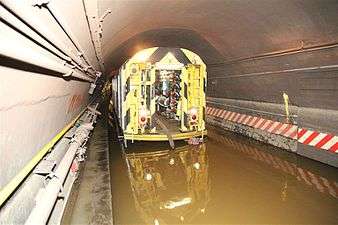R65 (New York City Subway car)
| R65 | |
|---|---|
 An R65 in the Cranberry Street Tunnel after Hurricane Sandy | |
| In service | 1989-present |
| Manufacturer | Kawasaki Heavy Industries |
| Built at | Kobe, Japan |
| Constructed | 1989[1] |
| Number built | 3 |
| Number in service | 3 (work service only) |
| Fleet numbers | PC01-PC03 |
| Operator(s) | New York City Subway |
| Specifications | |
| Car body construction | Stainless steel |
| Train length | 1 car train: 51.04 feet (15.56 m) |
| Car length | 51.04 feet (15.56 m) |
| Width | 8.60 feet (2,621 mm) |
| Height | 11.89 feet (3,624 mm) |
| Platform height | 3.65 ft (1.11 m) |
| Doors | 4 per car |
| Weight | 75,550 lb (34,270 kg) |
| Coupling system | Westinghouse H2C |
| Track gauge | 4 ft 8 1⁄2 in (1,435 mm) |
The R65s are New York City Subway cars purpose-built by Kawasaki Heavy Industries in Kobe, Japan, for pump train service. The exact date of their construction is unknown, but it can be estimated that they were built sometime after the R62s, which they heavily resemble. These cars are very similar to both the R62 cars and the R62A cars and are built to IRT specifications. However, they can be found on either division and are used on pump trains in the case of a flood. The R65s are numbered PC01-PC03
Unlike its revenue service counterparts, the R65s cannot move under their own power. Therefore, they are always seen being propelled by diesel locomotives.
References
- ↑ Corpsman, Joe. "NYCTA Work Cars 2013". The JoeKorNer.
- Sansone, Gene (1997). Evolution of New York City subways: An illustrated history of New York City's transit cars, 1867-1997. New York: New York Transit Museum Press. ISBN 978-0-9637492-8-4.
External links
This article is issued from Wikipedia - version of the 11/28/2016. The text is available under the Creative Commons Attribution/Share Alike but additional terms may apply for the media files.


